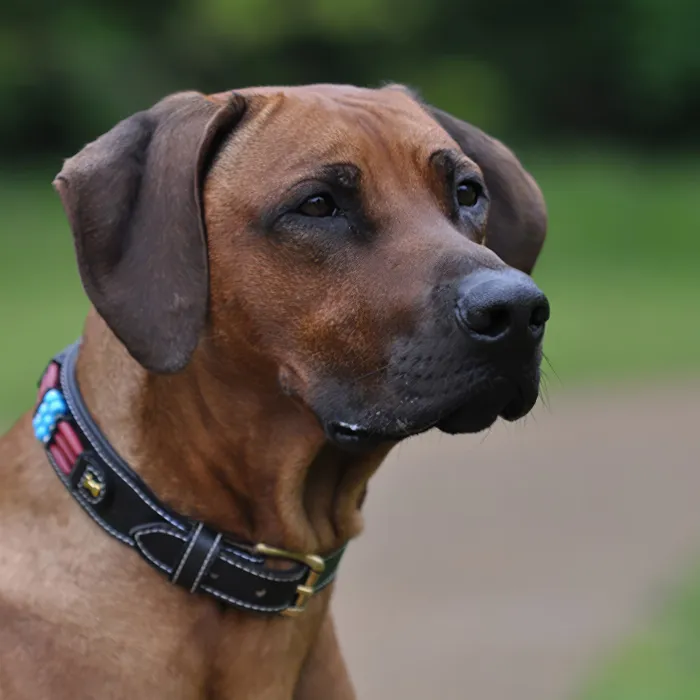Introduction
I was particularly looking forward to this tutorial as I want to make the cat as a motif a little more popular. There are now many good and well-known photographers who specialize in cats. And not without reason! Because cats are simply beautiful! Their magical eyes immediately cast a spell over the viewer, and when we see their big relatives on television, we can consider ourselves truly lucky if we can call them our own.
Our domestic cat is still a fearsome hunter, catching mice and birds with deadly precision, using its razor-sharp claws and teeth to catch its victim. But anyone who has ever watched a cat hunt knows that it is usually a long dance, a gruesome and macabre scenario between two unequal opponents.
The cat does not kill, it turns the hunt into a game in which there can only be one winner. Some owners are shocked when they suddenly see their own cat involved in such a spectacle. After all, our small, tame and purring furballs still have a hunting instinct, and when they get the chance, they act it out.
But the cat is not a monster, it is innate. Every step and every movement of a cat, no matter whether it is lying in wait in the meadow waiting to pounce on a butterfly or gracefully balancing on a balustrade: it is always a fantastic motif!
So let yourself be carried away by my tutorial on cat photography, find the treasure of the amber-colored eyes with me and fall in love with our rendezvous with the house cat!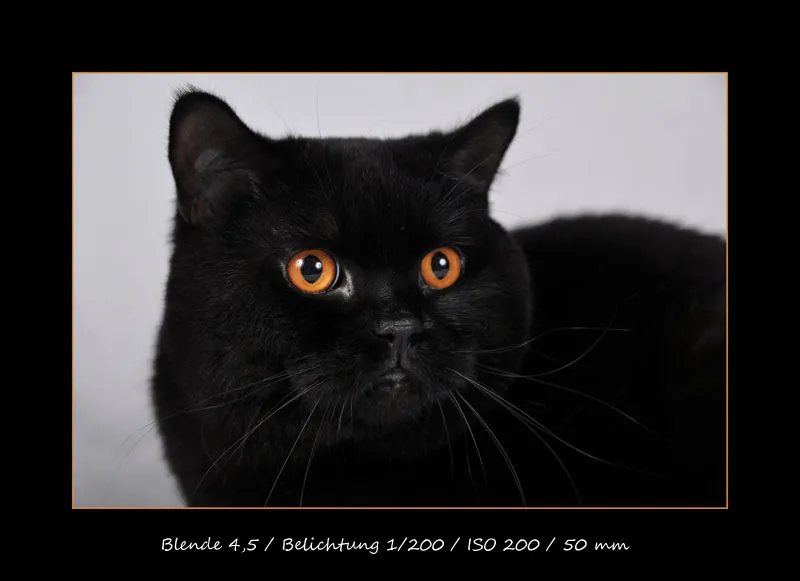
The tutorial is divided into a few subsections:
- Camera settings
- Position of cat and photographer
- The pedigree cat
- The little cat 1x1
- Instructions for the cat entertainer in the studio
- Kitty, sit! Tips & tricks on how to turn the unwilling kitty into a model
a. Outdoors
b. Studio - Kitten photography
As always I hope for positive and negative criticism, I am very happy that my tutorials have been well received by the readers so far and hope to be able to write all further parts just as satisfactorily for the reader! Many thanks for the great motivation in the form of thanks and positive votes! Now I hope you enjoy reading the cat photography tutorial!
1. camera settings
First of all: All pictures were taken with a Nikon D90. I work with the following lenses:
Sigma 18-50mm F2.8 EX DC Macro
Sigma 70-200mm F2.8 EX DG Macro HSM II
I also explain the individual camera settings in the studio photography tutorial and under outdoor shooting. Nevertheless, I would like to briefly touch on this topic here, as it was justifiably neglected in the dog photography tutorial. While you shoot in manual mode in the studio, you should perhaps - depending on your level of knowledge - start with automatic aperture priority outdoors.
Here you control the aperture size and the SLR does the rest for you! To achieve the right results with aperture priority and even manual mode, you will need to familiarize yourself a little with the camera settings. As this will certainly be great fun for you because it is very interesting, feel your way through everything slowly. Take your time!
Just read the manual for your camera, take a look at some websites on the Internet that explain and break down working with the digital SLR, talk to friends who have been taking photos with it for a while. And ask them! Again and again ... you can't make a fool of yourself. It takes a while to understand the interplay between Blender and exposure time. Draw from all sources of information what you can use for your hobby. The more information, the better!
Don't rely on working in auto mode. That's fine at the beginning, but you want to learn more about how your camera works and how you can get more out of your pictures with manual settings. What is important for you at the beginning:
Focus/exposure speed/blender
You should know what these terms stand for, what you can control with these things and what you can change by changing the values. This is not explained in three sentences and you will have to test it yourself in various situations in order to figure it out and eventually be able to make the right settings instinctively. Working with the SLR, which goes far beyond the points mentioned above, is a science in itself. And in the studio, completely different rules apply than when working outdoors.
Anyway, let's briefly touch on the main concepts:
a. Focus
The first thing you should forget about when photographing animals is auto focus. It is therefore important to find out how you can control your focus points manually. You should always be able to read about this in your user manual. This is not possible in every mode. But it is definitely possible in automatic aperture priority and sports mode. The focus should always be on the eyes for close-up shots. For more distant subjects, which may still be moving, it is sufficient to focus on the animal.
b. Exposure times
The right combination of exposure time and Blender is always important. The same exposure can be achieved with different combinations of shutter speed and Blender. Shorter exposure times and large Blenders freeze animals in motion and blur the background. Long exposure times and small Blenders, on the other hand, bring details in the background into focus and blur the animal in motion.
If you choose long exposure times (which I never actually use in animal photography), a waterfall, for example, becomes a beautiful blur of water.
If, on the other hand, you photograph it with short exposure times, you will be able to see almost every drop of water.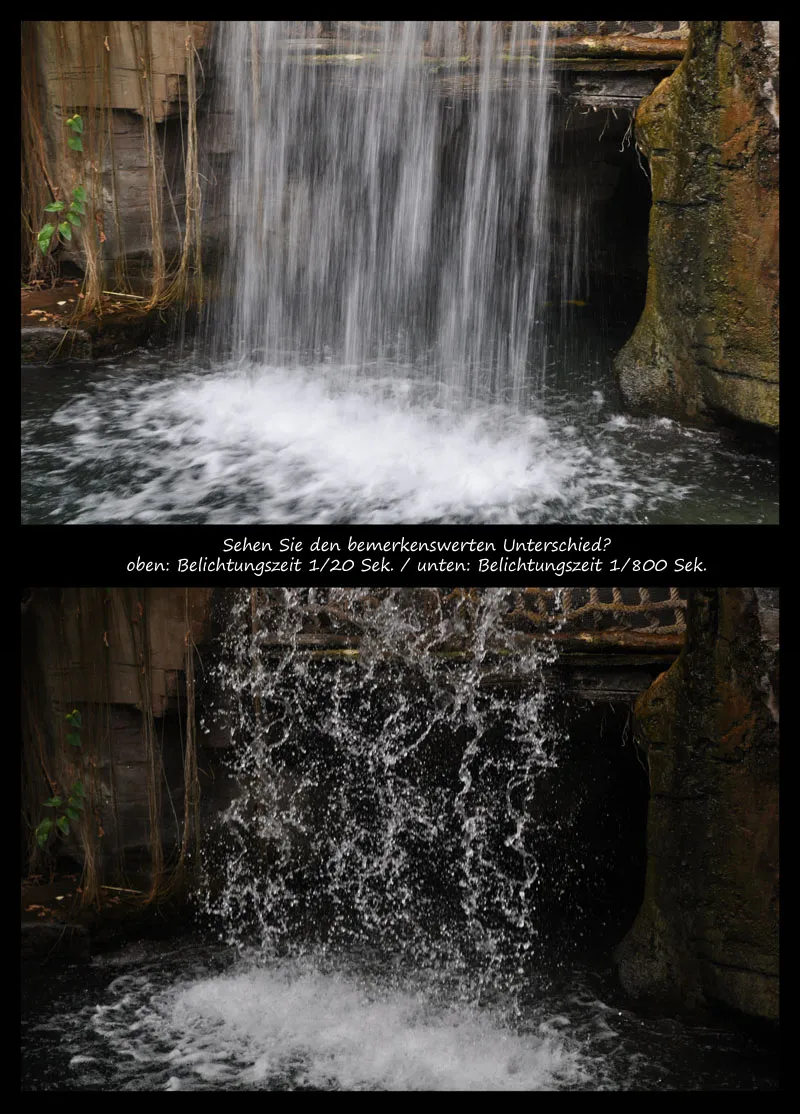
In the shot of Samy, you can see every drop of water falling off him, which gives the picture that certain something!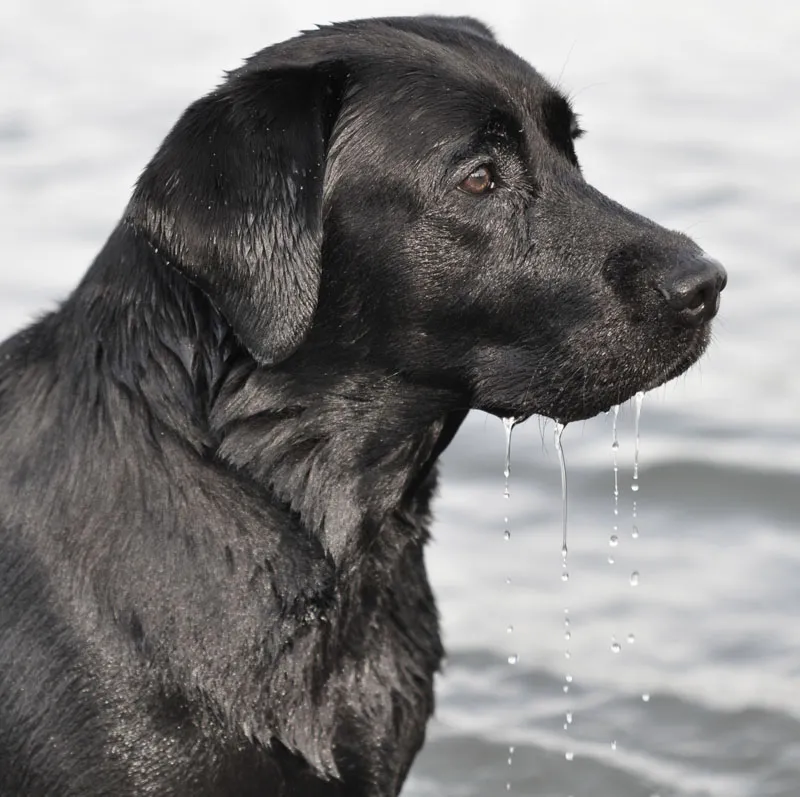
In the studio, I usually choose exposure times of approx. 1/125 or 1/200 sec.
c. Aperture
The aperture size controls the depth of field. You can simply remember the following rule:
- large aperture = small aperture value (e.g. 2.8) = shallow depth of field
- small Blender = large aperture value (e.g. 16) = large depth of field
You can clearly see the difference here. The focus is on a lantern flower in the right part of the picture. The top image was photographed with a small Blender (11), the leaves in the left part of the image, which are further back, are also almost in focus. The same image was then photographed (see lower image) with a large Blender. You can clearly see the difference in the left part of the picture. The lantern flower is sharp, the rest is blurred.
If you take a photo of a cat, for example, and select a shallow depth of field, the head, for example, will be in focus, but the rear part of the cat will be blurred. This gives the picture a completely different look than if both the cat and the background are in focus. However, if you want to photograph two animals next to each other that are slightly offset, you should select a smaller Blender (higher value). Then both animals will be in focus.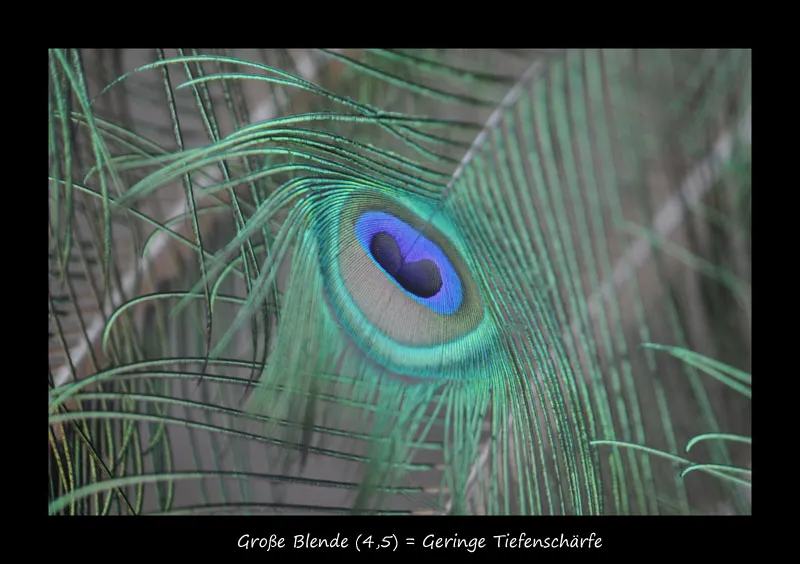
Of course, it also depends on your distance and the focal length. If you photograph a dog that is far away in motion with a large aperture (small Blender value), the dog will be completely in focus, only the background will be blurred.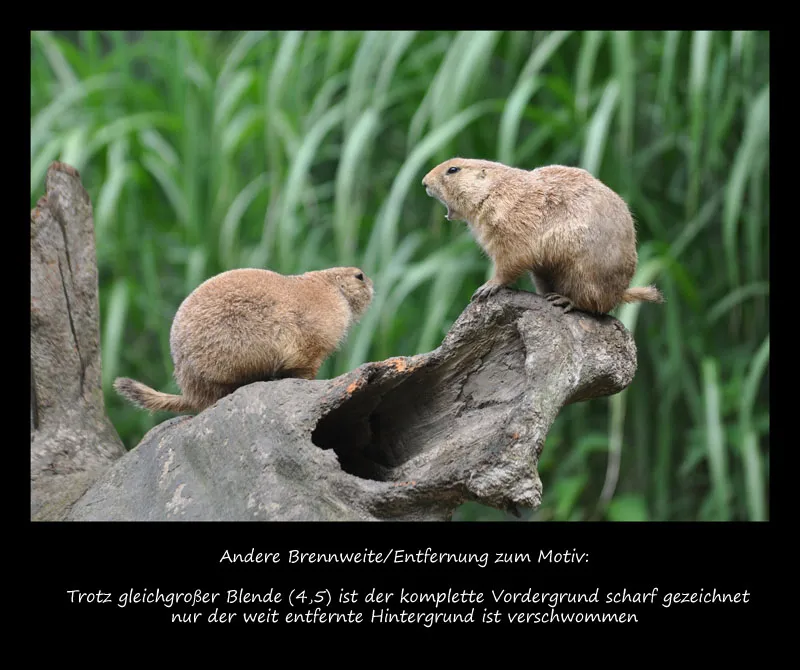
2. position of cat and photographer
As with dog photography, it is crucial that you are as close to eye level as possible. For almost all outdoor shots, if possible, I lie on the ground at eye level with the animal. For studio shots, I almost always kneel, as most cats are photographed on a table. They simply hold still better there.
Of course, sometimes I also take photos in the home (on the scratching post or the couch). It always depends on the wishes of the pet owner and, of course, how well the cat cooperates (see also Tricks in the Cat 1x1). If the animal absolutely won't stay on the studio table, I wait until it lies down somewhere relaxed (if I'm lucky, on a scratching post, for example) and carefully move up with the studio lamp. A lens with a long focal length can then be an advantage. The cat can stay comfortably in its favorite place and can be photographed in a relaxed manner.
This cat has retreated into his "little house". I therefore went to the floor and photographed him there in a completely relaxed pose. There he no longer perceived my equipment and me as a threat.
I had to leave this pretty long-haired cat alone again and again because it didn't want me near it. As you should never cause the animal stress, I kept trying to photograph it at a great distance. Finally, I managed to photograph her on the living room table.
3. the pedigree cat
Certain pedigree cats also have special characteristics. So if you are photographing pedigree cats, you may need to consult an experienced breeder on how best to photograph the cat. Just one example: A British Shorthair is a compact cat, which is of course best photographed like this and not lying stretched out across the table. A Maine Coon, on the other hand, is long and large.
A breeder once gave me the tip to take a photo a hand's breadth below the chin so that the expression and chin are perfectly emphasized. I can't say whether this is really true. I always photograph almost all animals at eye level, if possible. Here, too, the results are always satisfactory for the breeder. Nevertheless, it can be a good help to simply take such tips to heart and see for yourself!
So there is always a difference between photographing a "hobby animal" and an animal for breeding, which may also need to be presented appropriately on a website. It is the figurehead of the breed and therefore the photo should of course also show all the advantages of the animal.
This Maine Coon male was wonderfully large and long. The picture shows him very poorly. He looks small and compact. His beautiful chin does not come into its own, just like his beautiful collar and his expressive face, because he is so contracted.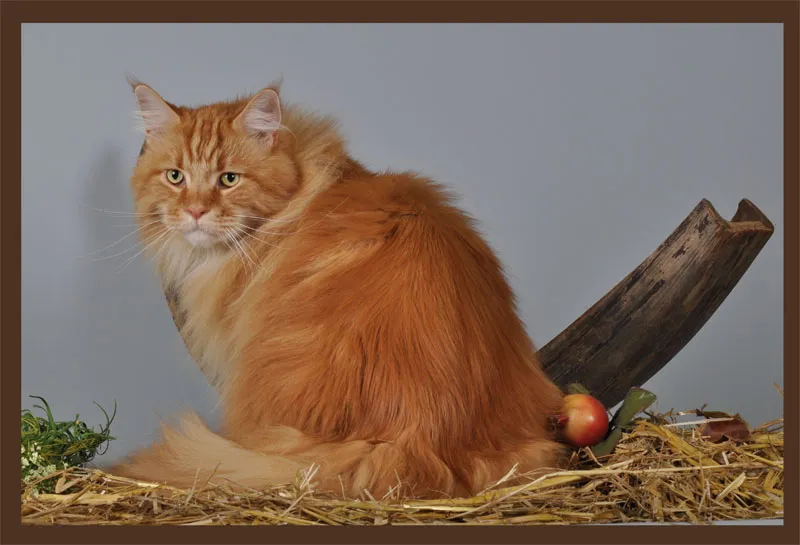
This little fellow here is a BKH male. As he is looking upwards at an unfavorable angle and was also photographed from below, his ears look too big.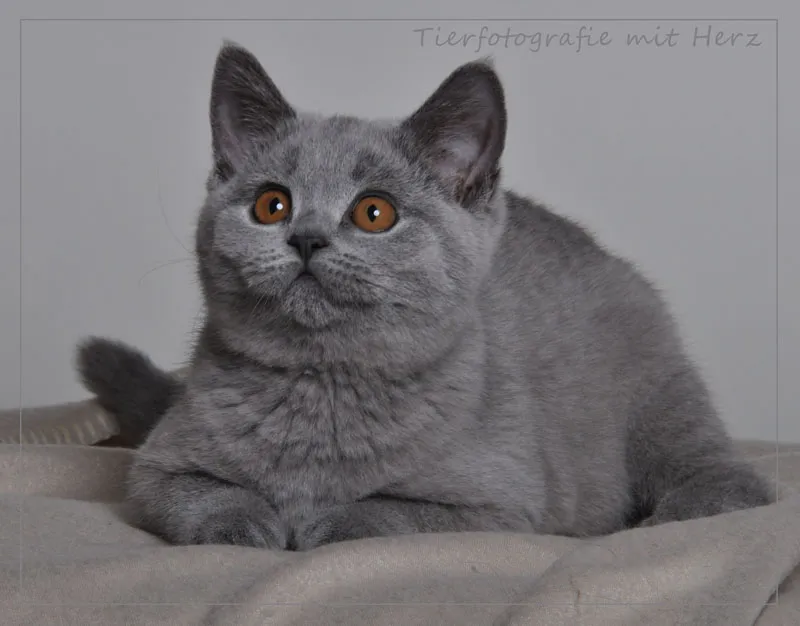
I admit it quite openly, I too often look with the eye of a lover. It takes a lot of experience for a layperson to be able to see which photo is "ideal" and where the cat has been shot unfavorably. Especially because breeders specialize in their cats and we may have to photograph many different breeds and know the characteristics accordingly.
It is a great advantage to buy a book about pedigree cats, where the most important characteristics are described. So if you are commissioned to photograph a cattery, you will at least know what you should emphasize in your photos. Whether this is successful is another question entirely. After all, we're talking about cats here!
4. the little cat 1x1
Do you have a cat? Then you probably know everything I'm about to tell you. Because there's one thing cats can't beat. Cats are terribly stubborn. Because what a cat doesn't want, it doesn't want. It doesn't want it now, it doesn't want it in ten minutes and it doesn't want it in three days. For the photographer, working with a cat requires an unspeakable amount of patience.
No animal has taken me for a ride in my work as obviously as the house cat. How often I put my camera aside because my "patient" simply refused to be photographed. During a short breather over a coffee, the cat does everything it didn't want to do for two hours beforehand. She poses on the studio table and flirts with the photographer for all she's worth. Of course, just like me, they think "get the camera quickly" - but by then 99.9% of the time the cat is busy in a completely different corner of the room, posing in the least photogenic way possible, e.g. licking its paw or lying with its head against the wall. Argh! I'm telling you, these animals do this with absolute calculation! If you look closely, you can see their sardonic grins very clearly! And that's exactly what makes them so adorable.
As I mainly photograph cats and occasionally breeders, this is where I have gained the most experience in the field of animal photography. I've gotten to know different cat breeds and cats of all ages. There are huge differences, but I like to divide all cats into three classes:
- The model cat
- The I-want-to-be-persuaded cat
- The I-don't-like-to-be-photographed cat (and if you stand on your head!)
Here are a few pictures:
Cat #1: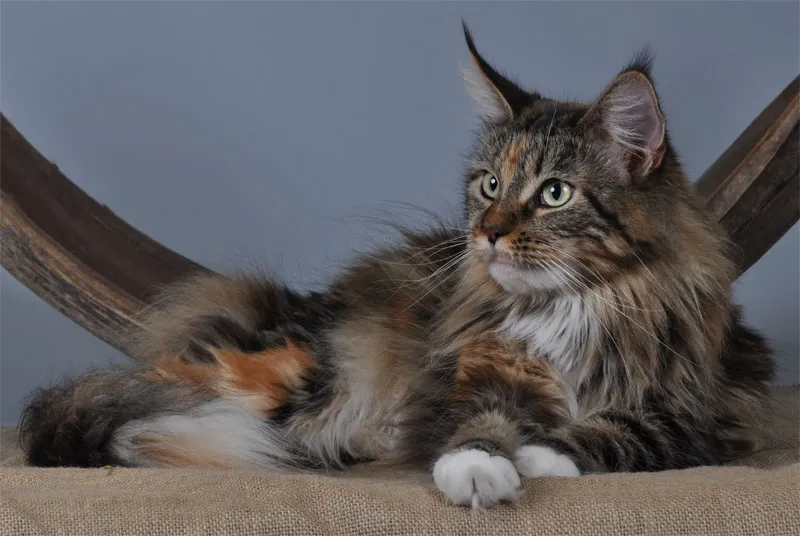
Elani, the pretty Maine Coon lady, is a definite model cat! She poses in front of the camera like a real model.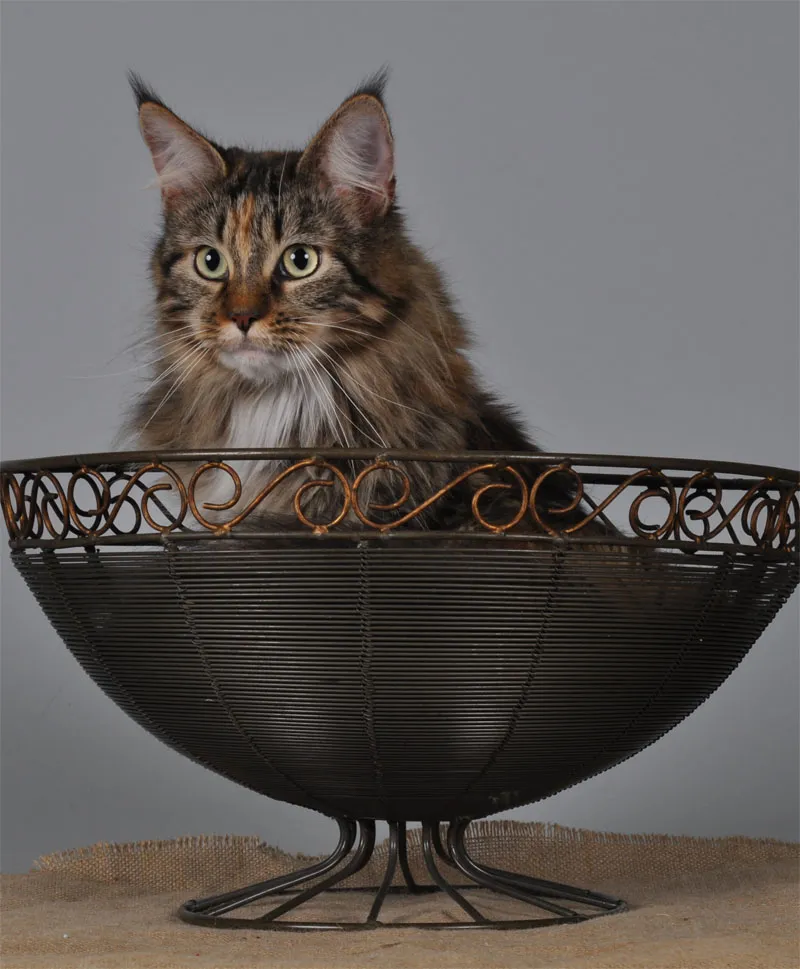
Cat no. 2:
Teddy is a beautiful male cat! He was our guest in the studio and gradually thawed out after a little persuasion with toys and cuddles. He didn't want to get on the studio table at all, so we put everything on the floor for him. If the cats don't play along the way you want them to, the photographer sometimes has to make do with poorer results (ear position, eye expression etc.).
Cat no. 3:
Ms. Smartie was my first real house cat shoot, and she really showed me up. She didn't want to be photographed at all in the studio if her owner wasn't at her side to cuddle her. Toys were of absolutely no interest to the old lady, and she wouldn't even let them lure her out of her shell. So we first had to go into the garden and later onto the sofa at home. Mrs. Smartie was photographed where she wanted to be photographed.
I have to say this quite frankly: Pedigree cats are generally very easy to photograph. I am therefore very spoiled, as I often have to deal with show-tested and very trusting cats. Almost all pedigree cats therefore belong to categories 1 or 2. There are very few cats that don't want to take part at all. They have usually had bad experiences with people at some point or are simply stubborn or initially nervous. They can usually be lured out of their reserve with toys.
A domestic cat requires far more sensitivity and, not least, patience. Some cats simply won't allow themselves to be photographed in the studio and will immediately run away outdoors if a stranger follows them - especially with suspicious equipment. If possible, always photograph cats in their familiar surroundings. For most cats, a car journey is already very unpleasant, then a completely unfamiliar environment, unfamiliar people ... this can very quickly scare a cat completely.
In addition to the typical character traits of cats, you also need to know how to trick your subject if you want to photograph these animals; I'll tell you in the Tips & Tricks section
5. instructions for the cat entertainer
First of all, you should instruct your "assistant", who is indispensable for studio shots, in detail. This is usually the pet owner or a friend who helps you to "entertain" your own cats while you are taking photos. Your assistant should do this if possible:
a. Hold the animal still
The helper should position themselves to the right or left of any animals that may jump off the table and intervene if necessary. He should be ready to hold the animal if it wants to jump. This is particularly important with kittens, as they could fall off the table and injure themselves. Photo cardboard lying across a table creases very quickly.
A cat jumping off the table and photo cardboard sliding backwards can cause quite a few dents. It is therefore best to secure the cardboard and make sure that the cat cannot jump off if possible. It will certainly get scared and will do it again and again. If the cat still successfully jumps off the table and seems stressed after 2-3 attempts, take a break or move to the floor.
b. Cat must remain in the background
The cat should be in the middle of the studio so that you can take the ideal photo. Not too close to the edges of the back wall and not too far in front or behind. Yes, it's not that easy, but you will always have to throw away or retouch a lot of pictures. I also often retouch fronds that are hanging in the picture or have to remove creases from the photo cardboard or similar. That is inevitable. Just tell your assistant where you would like the cat to be.
c. Animate the animal for the photo
If the animal is calm and stays in place voluntarily, the helper can take a position in front of the table so that it does not cover the lamps under any circumstances and of course does not stand in front of the photographer. A place next to the photographer is a good choice. Now you can use a toy fishing rod or something similar to draw the cat's attention towards the camera. Make sure that the cat does not jump off the table. Very active cats usually try to catch the object somehow. A little sensitivity is therefore required.
- The toy must not hang in the picture.
- The cat should look towards the camera, slightly upwards, left or right.
- The cat must not look too high.
It is best to "catch" the cat with a frond and then move it slightly above the camera. It will almost always follow with its eyes. If it starts to jump or loses interest, approach the cat again with the frond and play the game again.
Here the little kitten is not looking towards the camera, but this is also a very interesting angle.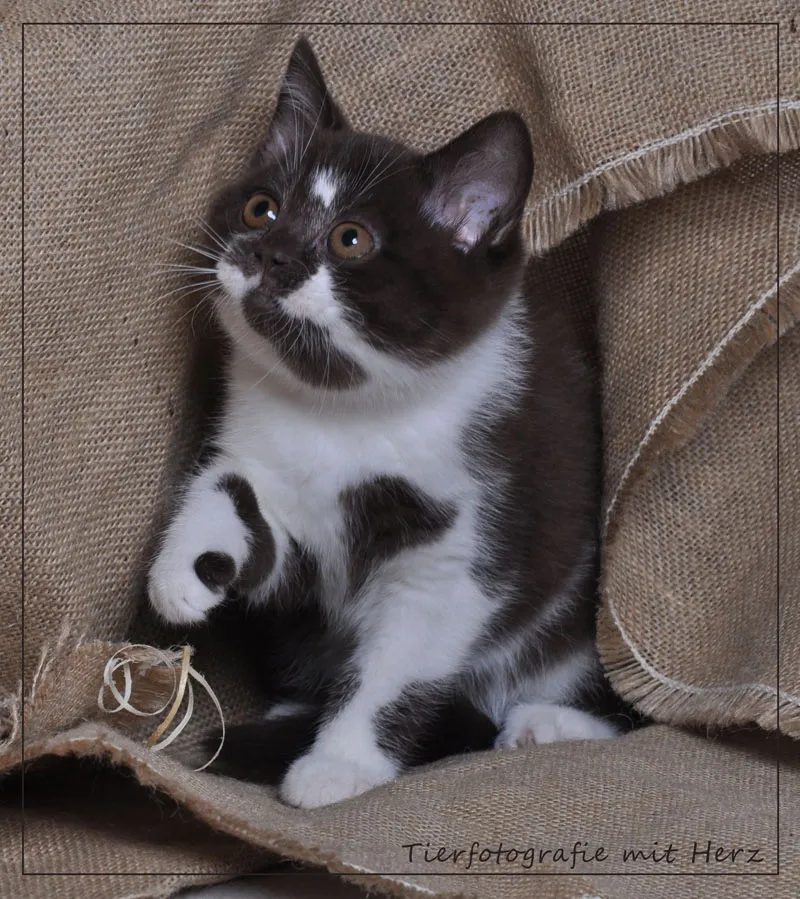
Here the kitten is playing with a frond that is hanging very high up at the time of the shot. In this way we encouraged the kitten to make males.
Unfortunately, the view is correspondingly high as a result. It is difficult to get the animal to stay in the pose at this exact moment, but to change the direction of its gaze. As a rule, it falls straight back onto all four paws. Such "perfect" shots are then more a matter of luck!
Your helper really contributes a lot to the shots. It will be a while before he is no longer standing in front of the studio lights or you in front of the camera. Feeding the cats is a very, very strenuous job. You won't be able to do both. In very rare cases with lenses with short focal lengths, I have already had my experiences with this. It always depends on the circumstances. Will the cat cooperate? Is the cat easy to play with? Is the background size suitable for petting without help?
I take most of my photos with a Nikon D90 and a Sigma lens with a focal length of 70-200 mm. Both together weigh over 2 kg. I can't hold it steady in one hand. Maybe for 1-2 shots. I do have a monopod, but I rarely take photos with it. I feel very inflexible with it. If I want to take photos with one hand and wave the other over my head, I can't change any settings (focus, Blender...).
I once photographed a nursery with about 10 kittens. Three litters of different ages with parents who could also move beyond the nursery. With a lighter lens, I was able to take many pictures on my own. Unfortunately, I soon had cats everywhere with the frond, as I couldn't separate them spatially. So soon one was sitting on my head, two were climbing up my trouser legs etc.
Only the one on the scratching post that I wanted to animate didn't react to me. What I'm trying to say is that you can photograph cats without help if they cooperate properly and let you animate them. For longer shoots - especially on a studio table - you won't be able to avoid help.
6 Kitty, sit! Tips & tricks on how to turn an unwilling kitty into a model
Every cat is "different". There are some cats who are not fazed by anything and others who are frightened by the slightest noise. For you as a photographer, it is important to find out how you can best turn Kitty into a model.
Some cats just need to be told, as already mentioned under no. 1. They climb all over the studio table and make themselves comfortable, all you have to do is pull the trigger. Unfortunately, we very rarely have to deal with cats like this, so in this section we'll focus on the absolute worst cases.
And as I have already mentioned, if you are tempted to tear your hair off your head, Kitty will be sitting on the table laughing! Of course, there are serious differences if the cat is to be photographed outdoors or in the studio, as follows:
a) Outdoor
With outdoor shots, everything is a little "easier", well, let's say "different". There are only two possibilities:
- The cat runs away and the photographer looks down the tube.
- The cat stays and allows itself to be photographed.
Of course, there are also certain differences here. You should always work with high focal lengths so as not to get too close to the animal. As a rule, cats roam through the garden at home, sit in a shady spot somewhere in the bushes or sunbathe on a table or similar. So it all depends on a bit of luck.
If you have a calm and trusting cat, you can of course persuade it with toys or treats to change places or to come to a place that is conducive to taking photos. Look for nice backgrounds. Soft, natural colors that don't distract too much from the subject. If you have a colorful cat, it is better to choose a plain tone. Otherwise it can be a little more.
Pay attention to this when you are looking for a place for Kitty to sit. Of course, you should also consider the light. In my opinion, the best times to take photos are until 11:00 in the morning or again from 15:00. If possible, use the evening sun in summer. Always take photos with the sun behind you, if possible. Avoid backlit shots altogether (unless intentional for some reason) and if there is no other way, take a slanted angle to the sun so that it does not fall through the sun visor.
If the cat gets nervous when you try to reposition it or get too close, patience is required. Approach as close as you can without the cat fleeing from you. Then simply wait until the cat becomes active and then take a photo. Perhaps you can ask your mistress to lure the cat out of the way if it is hiding in very unfavorable corners. Here, too, the motto is: wait and see.
Cats play, sleep or groom themselves. And you can take photos of them doing almost anything.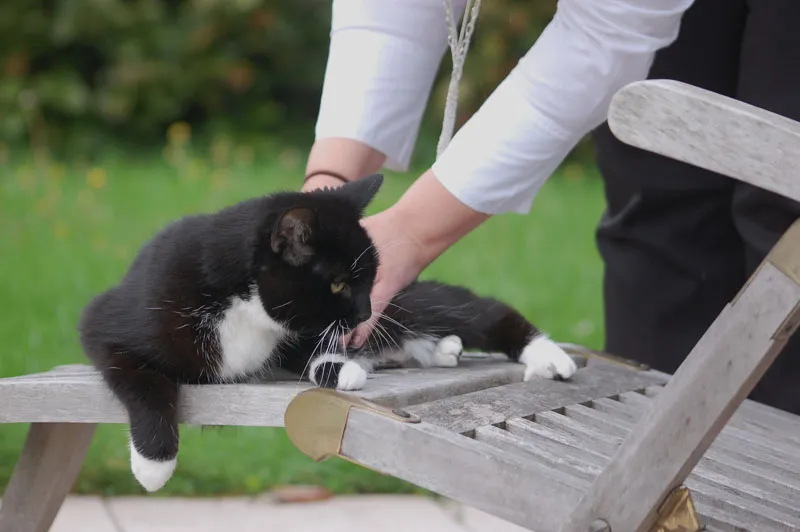
Well, we had imagined it would be so nice. But unfortunately Mrs. Smartie didn't stay there as we had hoped. She immediately jumped up and got into a less than photogenic position. To be precise: she held her backside up to the camera and yawned with pleasure.
This cat couldn't relax at all. You can clearly see the crouched posture and the cramped body. Distractions with toys or cuddles were out of the question.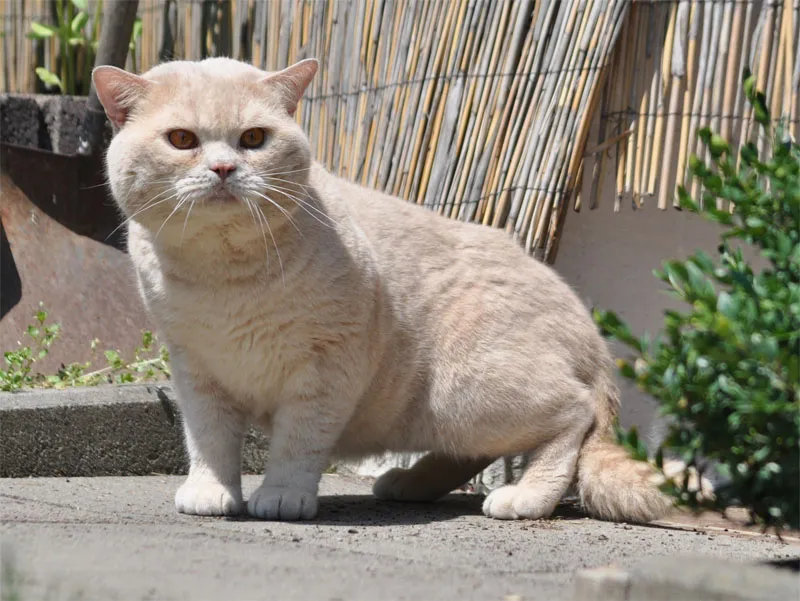
b) Studio
Different rules apply in the studio. Imagine the following scenario: You come to an acquaintance who has asked you to take some nice photos of his beloved cat with your great SLR. No problem, you say? Let me introduce you to a few category 3 kitty types; I'm curious to hear what you have to say ...
-Kitty greets you at the front door purring and is open and trusting. You might set up a studio lamp or simply follow her around the apartment and want to take a few photos. Kitty purrs around your legs and can't be persuaded to sit anywhere other than right next to you or somewhere between chairs or in the far corner of the living room where you can't reach her. Can you see her smile yet? So try your luck with treats and toys and lure her onto a nice fabric blanket in the light. A perfect background for her beautiful coat.
Kitty jumps at it at first, but either she's eating her treat while smacking her eyes loudly or she's turning her back to you - quite by chance, of course. You wait for the right moment with the camera in your hand. She has to turn around soon. She'll soon have eaten her treat and will certainly be looking at the camera.
There he is. You press the shutter release and it's over again. The moment has probably passed before you could capture it, or the picture is blurred or something similar - this is a shoot with Kitty, and if you think it's getting better, you're wrong. It's best to have a cup of tea and put the camera down. Then Kitty will do everything you want!
-Kitty is very trusting, but she lacks the curiosity typical of cats! Although she will sit sweetly on the studio table or wherever she is supposed to, she clearly shows her displeasure at having to be a model. Her posture is usually tense, her eyes are narrowed and her ears are laid back. She makes herself as unphotogenic as possible. She also smiles very clearly. Kitty is not anxious, but definitely listless. Usually this type is a tomcat disease.
They can only be photographed in one pose, huddled on the table with their ears back. The cat can neither be stimulated by toys nor by any interesting noises. It is one of those cats that will fall asleep bored on the studio table after about 20 minutes and will drive you, the photographer, crazy. She won't react to anything from then on. Not even if the house collapses or a jet flies through the garden.
-The last type of kitty is terribly jumpy and it takes a lot of patience and sensitivity to photograph this cat. Especially if you are not photographing the cat in its familiar surroundings, you will find it incredibly difficult. For example, we had two kittens in our apartment who were very anxious. We let them run around for over an hour and look around in peace, then we tried to lure them into the studio with toys. They didn't stay on the table, but fled immediately.
We moved the studio to the floor, but that didn't help either. They ran away immediately. It was a real test of patience with toys of all kinds to get them to the place where they were to be photographed. At every little noise, the cats jumped behind the couch and it was difficult to lure them out again. This cat will really demand everything from you. You will be delighted with every successful picture afterwards and you will have to be just as inventive and creative as with cats a and b!
Of course, there are also cats that react so frightened of you and the camera or even aggressively that a shoot makes no sense at all.
Although it rarely happens to me, it has nevertheless happened that a cat at a show was so stressed by the previous procedures (car journey, show environment, judging etc.) that it completely lost its patience on the studio table and snarled at everything around it. Stop the shoot immediately. Anything else would be cruelty to animals!
This cat is scared! It must be taken out of the studio immediately.
Even when his owner tries to release him, he becomes aggressive. It was immediately clear that D'Artagnon could not be photographed in the studio. He must be left alone immediately. D'Artagnon is a very, very sweet cat who is very cuddly and affectionate. His reaction to the studio was unpredictable for us.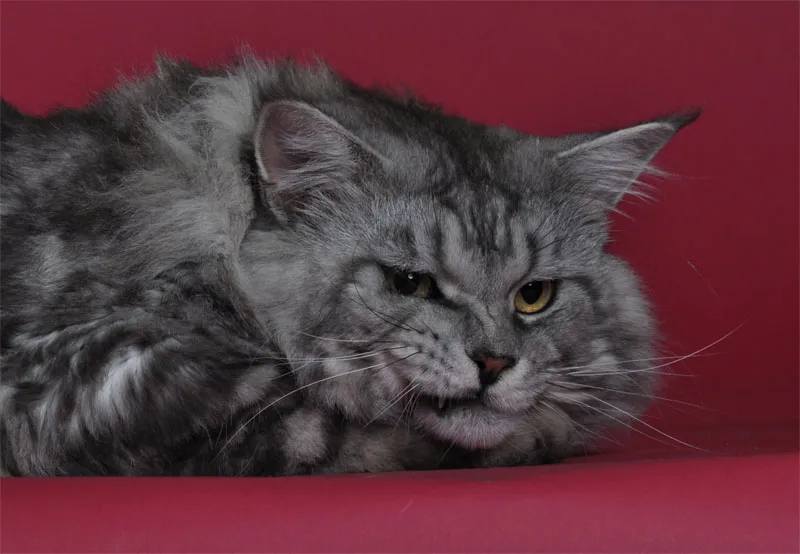
Another no-go is photographing very anxious animals. Cats can suffer a heart attack - especially young animals. If it's still hot in summer and the animals are very excited due to stress and nervousness, you and the owner are putting the cat at great risk. You must prevent this at all costs.
Even if the animal owner desperately wants beautiful photos, bring him to his senses.
On hot days, as already mentioned, cats may pant. The photo shoot must also be stopped immediately. The cat must immediately be given a place to retreat to where it is shady, cool and above all quiet.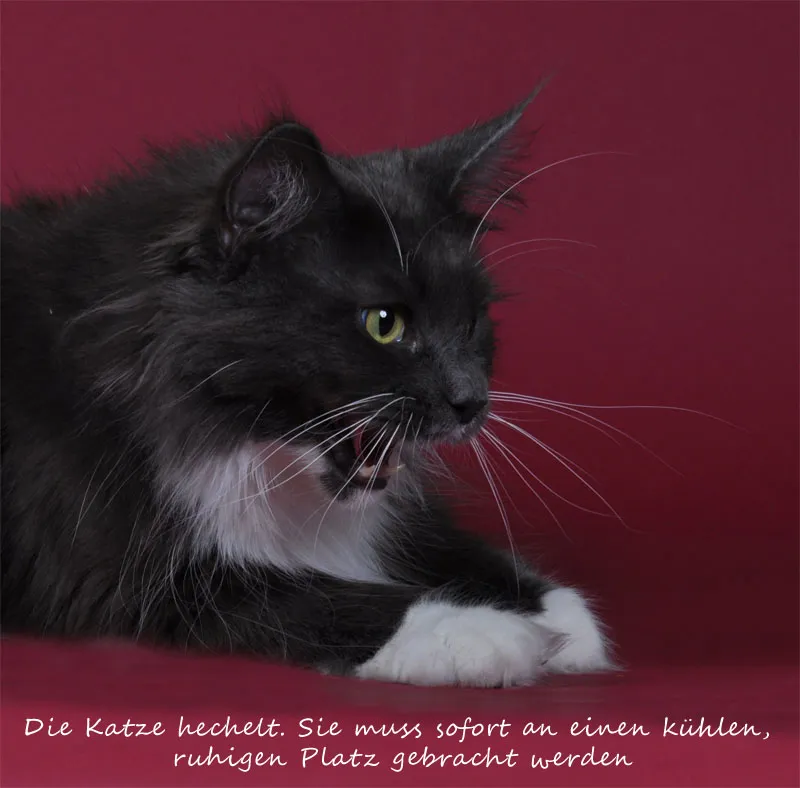
But now to your options for motivating cats that don't want to play along at all and setting the scene for a few nice photos! Always be absolutely patient and, if necessary, reassure the pet owner, who will probably soon be just as stressed as the animal. They are so keen to have beautiful photos of their beloved four-legged friend that they may forget that the fun is already over for Kitty. Intervene in good time. If you notice that it's getting too exhausting or nerve-wracking for Kitty, the pet owner or even for you, take a break!
I'll let you in on a little secret: When I have really stressful shoots, sometimes lasting a whole day with lots of animals, it happens to me that at some point I'm completely at the end of my tether. Then I need some time to regenerate. Photography is a lot of fun. But if you are constantly holding the heavy camera and lens in your hands and have nervous pet owners next to you with demands on the photographer that are sometimes not easy to fulfill, as well as children playing around you and animals that don't want to cooperate at all, it can be really exhausting after a few hours.
I am a very, very strong-nerved and stress-resistant person and yet sometimes it's too much for me too. Take a break! Anything else makes no sense at all. So if you're photographing a cat that doesn't want to participate at all and you notice that impatience or a certain tension is building up inside, then put everything to one side for 10 minutes. You will realize how much this helps. For the animal, the owner and, above all, for you. Afterwards, you'll be in a good mood and full of energy to get back to work and maybe Kitty will be persuaded to take a few pictures after all!
Trick no. 1: Toys
The be-all and end-all with cats is, of course, toys. It often works to encourage cats that seem a little nervous or even distracted with a toy. You should have already instructed your helper, see above. You can use it to catch the cat's eye and try to direct it towards the camera. Fronds or toy fishing rods are particularly suitable.
This trick is suitable for slightly tense or nervous animals that respond well to toys. You can almost always get kittens this way! The animals usually relax noticeably and eventually completely forget where they are and that they are being photographed.
Trick no. 2: Noises/movements
Cats that don't react to toys at all and sit on the table unmotivated or tense can occasionally be stimulated with interesting (but not frightening!) noises. The ears are often a problem here, pointing in all directions but not where they should be.
By making noises (e.g. a soft rustle) or moving an interesting object in a corner of the room behind the photographer, it may be possible to direct their gaze in the right direction and their ears too! We have already spent over an hour with three people trying to animate a cat who was lying totally limp and too relaxed on the table.
His ears were pointed somewhere in the background and he lay there like a pancake, not allowing himself to be animated to do anything. We pulled out all the stops. We waved artificial flowers and feathers, rattled boxes and whistled around. He wasn't interested in anything. This is a rare occurrence, but it does happen occasionally with cats. As always, patience is the only thing that helps here. It's not as if we couldn't take a few nice photos of him.
Here is the candidate. Before, he was lying on the table totally unmotivated, his ears hanging in all directions, his eyes bored. We later put him in the picnic basket and the photo on the right was taken. The cat is much more interested and alert in his expression. Admittedly, he still doesn't look really happy.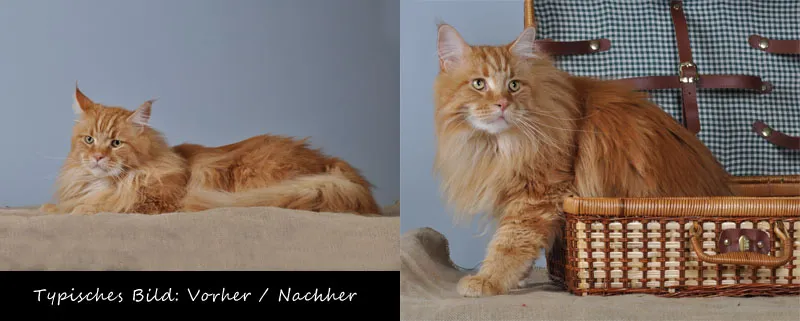
Trick no. 3: Cuddling
Cats that are very attached to their owner and cuddly can be persuaded to stay on the studio table by touching and cuddling. Their owner just needs to be close enough to them and occasionally cuddle them here and there, then all is well. These animals usually react very anxiously to loud noises or strangers, so you should try to make yourself invisible. Leave everything to the pet owner and instruct them well beforehand. Instead of wiggling toys, whenever the animal shows signs of fleeing, he should simply scratch it a little until the cat relaxes. As soon as this happens and the owner's hand disappears from the picture, take a few quick photos.
Trick no. 4: Treats & catnip
For cats that just won't relax and don't respond to any of the above, try bribing. Yes, not a clean thing, I know. Put a few treats on the study table or spray a little catnip. This doesn't work with all cats, but it's worth a try. Leave the cat completely alone while it eats or enjoys the catnip and perhaps rolls around on the table. This has really worked even with very nervous animals. Try it out if you can't think of anything else.
Trick no. 5: Let the cat decide
If you have already tried everything but the cat just doesn't want to be photographed, give it a break first. The prerequisite for not aborting the shoot is that the cat does not appear anxious, stressed or even aggressive. Then, as already mentioned, the shoot should always be stopped immediately. However, there are very often cats that don't react to any of the above, but are calm when they don't have to stay on the studio table. If they won't let anything get them on the table, there is only one option left. Let the cat decide where it wants to be photographed.
For example, you can move the studio to the floor. The background system can easily be adjusted, the table removed and you try to place the cat in front of the background again. If none of this works, find a nice place in the living room or similar where the cat likes to lie. This could be a sofa, a scratching post or similar and simply place your studio lamp there. You can now place the cat there. See what it does. If none of this helps, let the cat choose a place. Simply photograph the cat where it sits or lies down. This has always worked so far!
These two kittens, Luna and Merlin, also kept us busy with three people. The two kittens were 9 and 10 weeks old at the time of admission and very, very shy. It took us a long time to even get them out from behind the sofa. In the end, we had to photograph them where they wanted to be. They were playing under a glass table on the living room carpet.
Certainly not the most beautiful background and difficult to light. The studio lamp was set up accordingly and we tried our luck. There was no other way. The cats were not afraid and relaxed immediately when they were able to play. But they were also very shy and hid in a corner at the slightest noise. This requires a lot of calm and patience from the helpers and the photographer.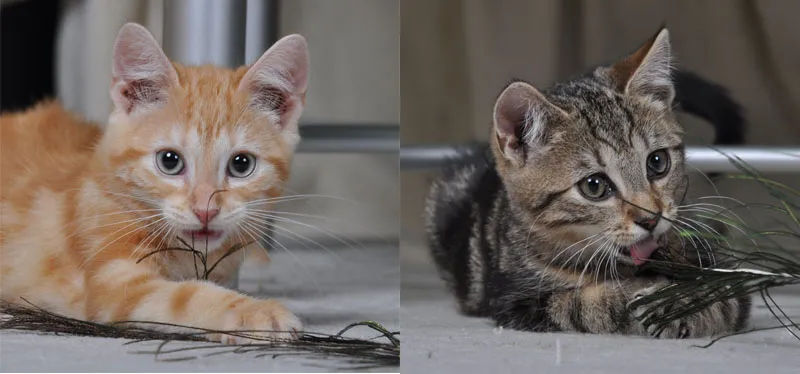
7. kitten photography
As I photograph so many kittens, I would like to point out one more thing. Like all babies, kittens should be treated with special care. There are babies who really let everything happen to them, but there are also some who should be treated with absolute caution simply because of their age.
Kittens up to the age of four weeks get virtually nothing around them. You can't stimulate them with toys or noises. Here I usually limit myself to a few shots; the kittens should not be photographed for too long! Not least because it is stressful for both the little ones and the mother. The kittens almost always have small milk mouths. It is very difficult to get several kittens of this age in the picture, all facing the camera.
This kitten is only 3.5 weeks old and does not react to sounds or toys.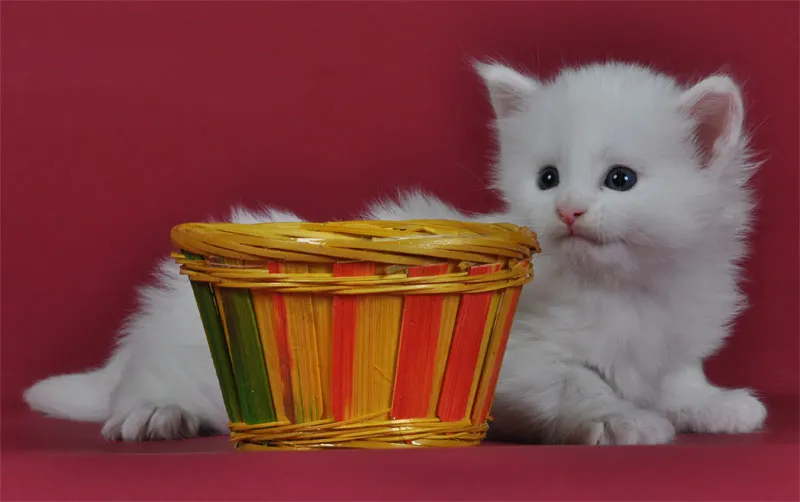
The best time to photograph kittens is when they are 7-10 weeks old. They react to toys, are incredibly cute and are usually already very curious and trusting. Even though I work a lot with decoration, it is very important to me that the kittens are totally relaxed. Anxious kittens or kittens that call for their mother should be "released" immediately.
And even with the most relaxed babies, you should never overdo it. Even I sometimes get carried away and have to stop myself because I want to take this, that and the other photo of a kitten that is cooperating well. Especially when the pet owner is just as euphoric.
Here is a kitten of the right age and a born model! Caramello was visiting the studio ...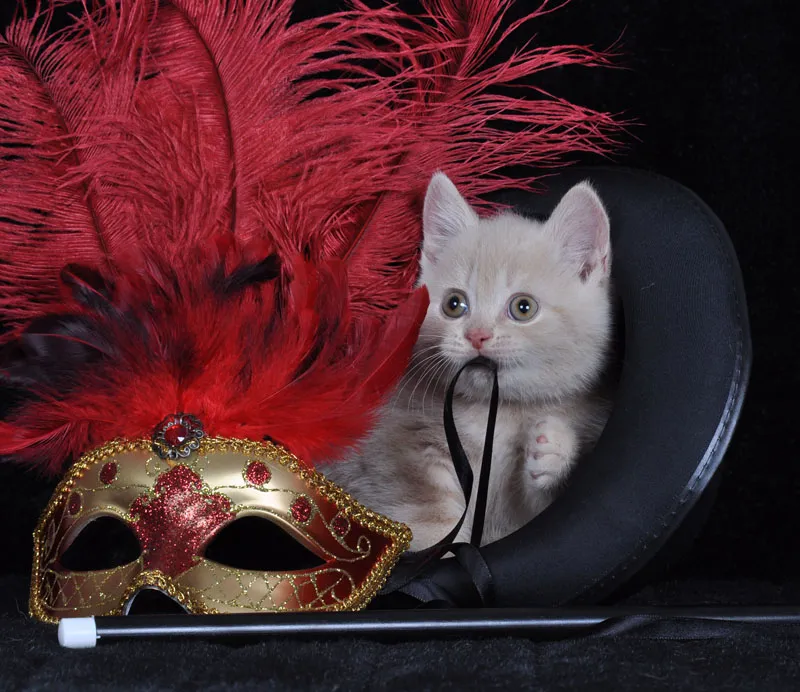
... with his brother Risotto.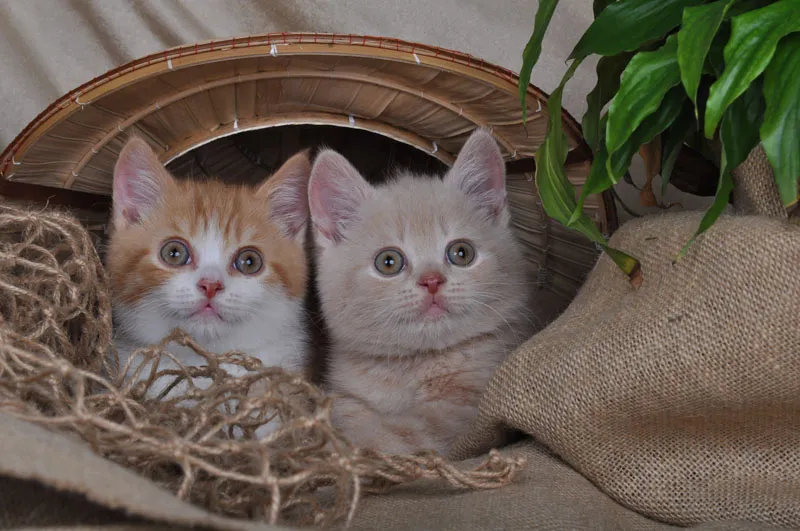
He really enjoyed working with us ...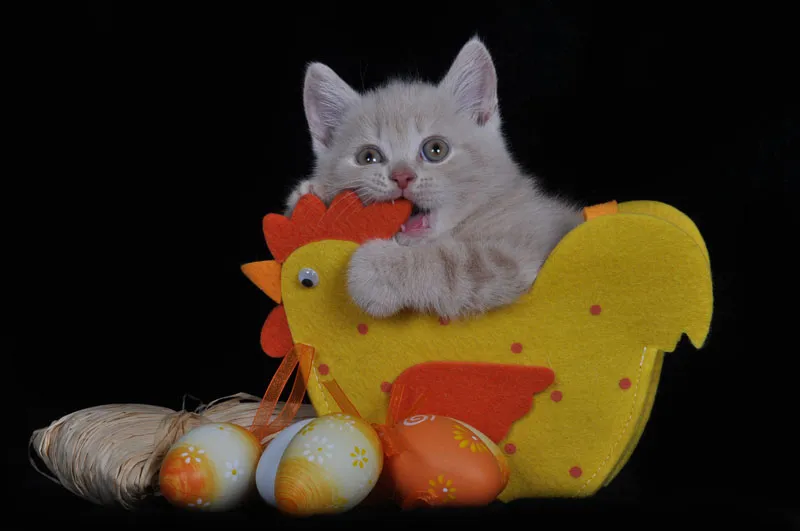
... and wanted to take the decoration home with him: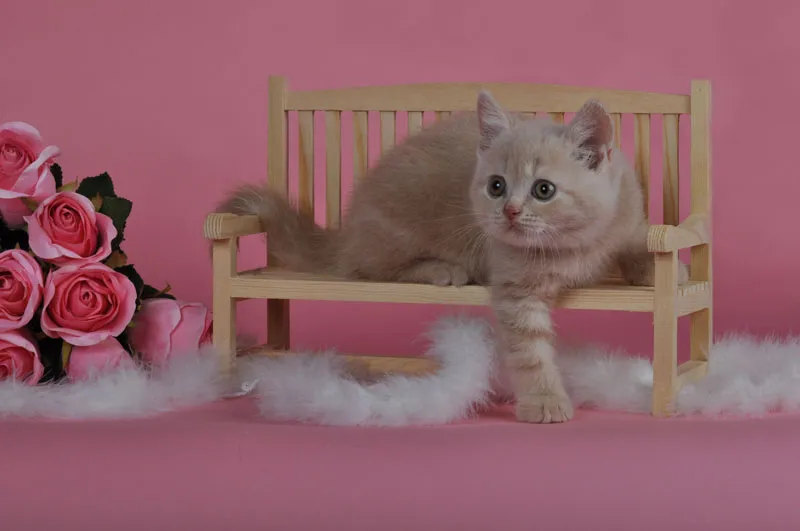
Kitten photography is one of the best things about pet photography! But let your models have as much fun as you do. Some cats don't want to cooperate and are afraid. Respect this and explain it to the pet owner if they don't want to give up. I have photographed every cat so far and you will be no different. You may just have to play by the cat's rules! And what could be better? A rendezvous with your cat is something so wonderful! I hope you enjoyed it!
Until the next tutorial!
Nicole Schick
www.tierfotografie-mit-herz.de
